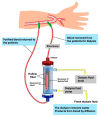Influence of Dialysis Membranes on Clinical Outcomes: From History to Innovation
- PMID: 35207074
- PMCID: PMC8876340
- DOI: 10.3390/membranes12020152
Influence of Dialysis Membranes on Clinical Outcomes: From History to Innovation
Abstract
Dialysis membranes were traditionally classified according to their material compositions (i.e., as cellulosic or synthetic) and on the basis of the new concept of the sieving coefficient (determined by the molecular weight retention onset and molecular weight cut-off). The advantages of synthetic polymer membranes over cellulose membranes are also described on the basis of their physical, chemical, and structural properties. Innovations of dialysis membrane in recent years include the development of medium cutoff membranes; graphene oxide membranes; mixed-matrix membranes; bioartificial kidneys; and membranes modified with vitamin E, lipoic acid, and neutrophil elastase inhibitors. The current state of research on these membranes, their effects on clinical outcomes, the advantages and disadvantages of their use, and their potential for clinical use are outlined and described.
Keywords: cellulose membranes; dialysis membranes; graphene oxide membranes; mixed-matrix membranes; synthetic polymer membranes.
Conflict of interest statement
The authors declare no conflict of interest.
Figures



References
-
- Kiil F. Development of a parallel-flow artificial kidney in plastics. Acta Chir. Scand. Suppl. 1960;253:142–150. - PubMed
Publication types
Grants and funding
- MOST 107-2314-B-075-052, MOST 108-2314-B-075-008, MOST 109-2314-B-075 -067 -MY3/Ministry of Science and Technology
- V109D50-001-MY3-1, V109D50-001-MY3-2, V110C-152/Taipei Veterans General Hospital
- No.104-V-B-044/Taipei Veterans General Hospital-National Yang-Ming University Excellent Physician Scientists Cultivation Program
LinkOut - more resources
Full Text Sources

